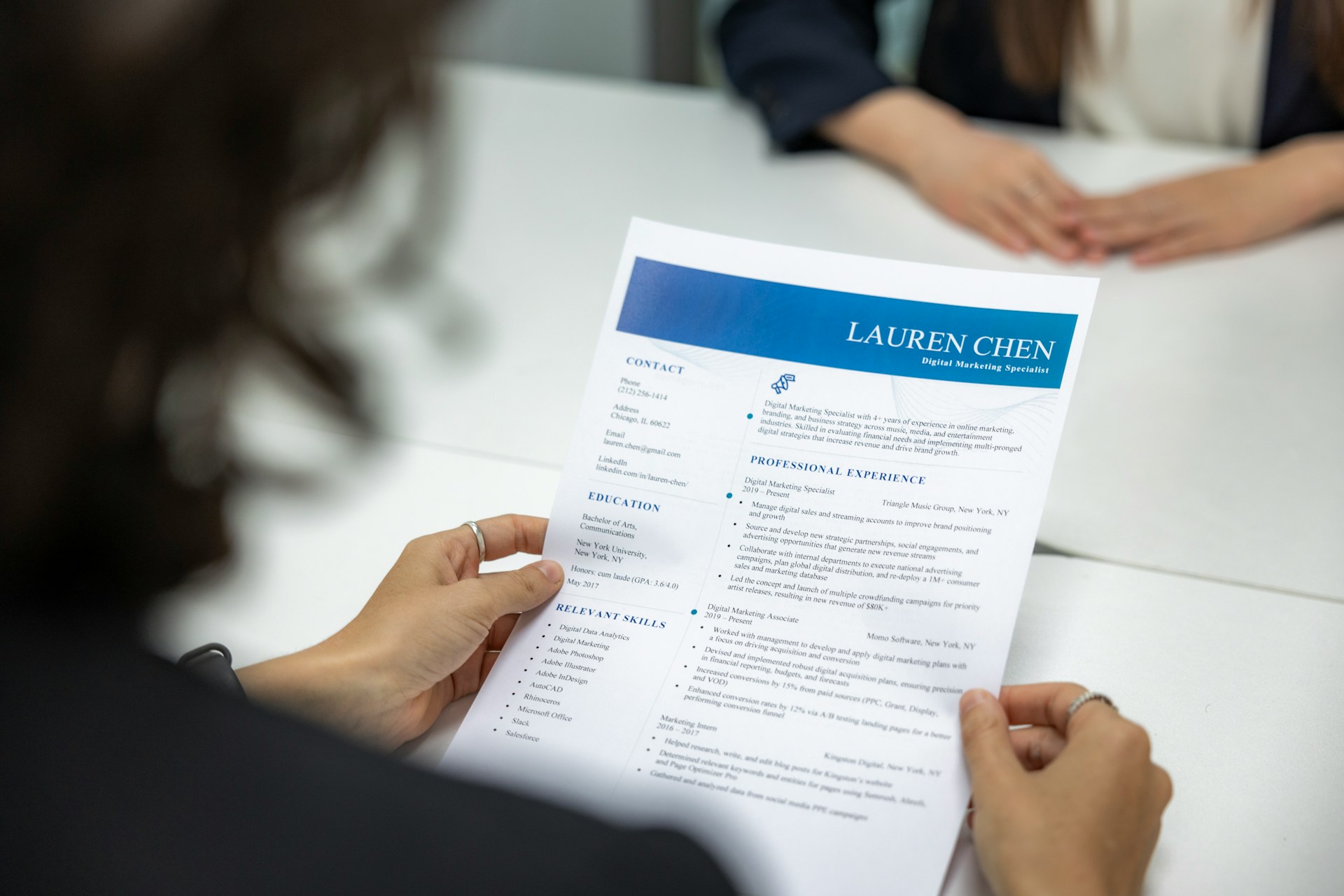Congratulations! You’ve landed a job interview for your dream position. This is an exciting step, but it can also be nerve-wracking. Don’t worry, with the right preparation and approach, you can confidently showcase your skills and leave a lasting impression on the interviewer. This comprehensive guide equips you with the top job interview tips to navigate the process with ease and land your dream job.
Interview Landscape: Preparation is Key
Imagine yourself walking into the interview room, calm, collected, and ready to impress. Preparation is the key to achieving this confidence. Here’s why:
a. Boosts Confidence:
Researching the company and practicing your answers beforehand alleviates anxiety and allows you to approach the interview with self-assurance.
b. Makes a Strong Impression:
A well-prepared candidate demonstrates initiative, attention to detail, and genuine interest in the opportunity.
c. Stands Out From the Competition:
In a competitive job market, taking the time to prepare can set you apart from other qualified applicants.
So, how do you prepare effectively?
Research the Company and Role:
Invest time in researching the company’s mission, values, and current projects. Understanding their goals allows you to tailor your responses and showcase how your skills align with their needs. Research the specific role you’re applying for as well. Familiarize yourself with the responsibilities and highlight relevant skills and experiences in your interview answers.
Understanding Different Interview Formats:
Interviews come in various formats, and knowing what to expect can help you adjust your approach. Here’s a quick breakdown:
1. One-on-One Interviews:
A classic format where you meet with a single interviewer from the company.
2. Panel Interviews:
You’ll be interviewed by a group of people from different departments within the company.
3. Phone Interviews:
A convenient way for initial screenings. Treat it seriously and prepare as you would for an in-person interview.
4. Video Interviews:
Similar to a phone interview but conducted virtually through a video conferencing platform.
Crafting Your Interview Narrative: Highlighting Your Strengths
Imagine your interview as an opportunity to tell your professional story. This story should showcase your skills, experiences, and how they make you the ideal candidate for the role. Here’s how to craft a compelling interview narrative:
Developing a Compelling Interview Story:
Think of your interview as a chance to tell a captivating story about your professional journey. This story should highlight your achievements, skills, and how you’ve tackled challenges in previous roles.
The STAR Method:
The STAR Method (Situation, Task, Action, Result) is a powerful framework for structuring your answers to behavioral and situational interview questions. Here’s how to use it effectively:
a. Situation:
Briefly describe the context or scenario you faced.
b. Task:
Explain what your specific responsibility or task was in that situation.
c. Action:
Detail the specific actions you took to address the situation.
d. Result:
Describe the outcome of your actions and the positive impact you made.
By using the STAR Method, you can provide clear, concise, and impactful answers that showcase your problem-solving skills, initiative, and ability to achieve results.
Anticipating Common Interview Questions:
Preparation is key! Here’s a list of common interview questions categorized by type to get you started:
a. Tell me about yourself
This is your chance to introduce yourself with a clear, concise, and career-focused summary. Highlight your most relevant skills and experiences that align with the job description.
b. Why are you interested in this position?
Go beyond just needing a job. Express your genuine interest in the company, the role, and how your skills can contribute to their success.
c. Why should we hire you?
This is your moment to shine! Briefly highlight your unique skills, experiences, and qualities that make you the perfect candidate for the role.
d. What are your strengths and weaknesses?
Frame your weaknesses as areas for development. For strengths, use the STAR Method to showcase a specific example of a strength in action.
e. Do you have any questions for us?
Absolutely! Prepare insightful questions that demonstrate your interest in the company, the role, and the team.
Here are some additional tips for crafting your interview narrative:
Quantify Your Achievements:
Whenever possible, quantify your accomplishments using numbers or percentages. This demonstrates the impact you made in previous roles.
Tailor Your Responses:
Don’t give generic answers. Carefully review the job description and tailor your responses to highlight the specific skills and experiences they’re looking for.
Be Enthusiastic:
Your passion for the opportunity should shine through! Speak with enthusiasm about the company, the role, and your potential contributions.
Mastering the Art of Nonverbal Communication
First impressions matter. Nonverbal communication plays a significant role in how you’re perceived by the interviewer. Here’s how to master the art of nonverbal communication:
a. The Power of First Impressions:
You only get one chance to make a first impression. Project confidence and professionalism from the moment you walk into the room.
b. Body Language:
Maintain good posture, make eye contact, and use natural hand gestures to convey confidence and engagement. Avoid fidgeting, slouching, or crossing your arms, as this can come across as closed-off or nervous.
c. Dressing for Success:
Dress professionally and appropriately for the company culture. A polished appearance shows you take the interview seriously and respect the company. When in doubt, err on the side of formality.
Interview Day Do’s and Don’ts: Navigating the Big Day
You’re prepared, confident, and ready to go! Here’s a quick guide to navigating interview day with grace:
Do:
a. Arrive Early:
Punctuality shows respect for the interviewer’s time. Aim to arrive 10-15 minutes early to avoid any last-minute stress.
b. Dress Professionally:
As mentioned earlier, dress professionally and appropriately for the company culture.
c. Greet Everyone with a Smile:
Be polite and courteous to everyone you meet, from the receptionist to the interviewer.
d. Maintain Eye Contact:
Eye contact shows confidence and attentiveness. Make eye contact with the interviewer throughout the conversation.
e. Actively Listen:
Pay close attention to the interviewer’s questions and respond thoughtfully.
f. Ask Thoughtful Questions:
Prepare insightful questions that demonstrate your interest in the company and the role.
g. Express Enthusiasm:
Express your enthusiasm for the position and the opportunity to join the company.
h. Thank the Interviewer(s):
Thank the interviewer(s) for their time and consideration.
i. Follow Up with a Thank-You Email:
Send a thank-you email within 24 hours of the interview, reiterating your interest in the position.
Don’t:
a. Be Late:
Punctuality is essential. Being late creates a negative first impression.
b. Dress Inappropriately:
Avoid overly casual or revealing clothing.
c. Speak Negatively About Previous Employers:
Focus on the positive aspects of your past experiences and how they prepared you for this role.
d. Fidget or Appear Nervous:
Take deep breaths and try to relax. Excessive fidgeting can be distracting.
e. Answer Your Phone:
Silence your phone during the interview.
f. Chew Gum:
Avoid chewing gum or eating anything during the interview.
g. Lie on Your Resume:
Be honest and truthful in your responses.
h. Badmouth the Company:
Research the company beforehand and avoid making negative comments during the interview.
i. Ask About Salary or Benefits Prematurely:
Focus on showcasing your qualifications first. Salary and benefits can be discussed later in the interview process.
Beyond the Basics: Advanced Interview Techniques
Now that you’ve mastered the fundamentals, let’s explore some advanced interview techniques:
Handling Difficult Interview Questions:
Even the most prepared candidate can encounter challenging questions. Here’s how to handle them:
a. Stay Calm:
Don’t panic. Take a deep breath and gather your thoughts before responding.
b. Clarify the Question:
If you’re unsure about the question, ask for clarification before answering.
c. Use the STAR Method:
This method can be helpful for structuring your response to difficult questions, even those about salary negotiations or addressing gaps in your resume.
d. Focus on the Positive:
Even if you’re discussing a weakness, frame it positively and emphasize how you’re working on development.
e. Turn It Around:
If a question feels negative, try to reframe it into an opportunity to showcase your strengths.
Behavioral and Situational Interview Questions:
These questions delve deeper into your problem-solving skills and work ethic. Here’s how to tackle them:
a. Identify the Problem:
Clearly identify the central issue or challenge presented in the question.
b. Describe Your Actions:
Explain the steps you took to address the problem.
c. Focus on Your Impact:
Highlight the positive outcomes of your actions and the impact you made.
Selling Yourself and Your Value Proposition:
In a competitive job market, it’s crucial to showcase your unique value proposition. Here’s how:
a. Identify Your Skills and Strengths:
Reflect on your skills, experience, and unique qualities that make you a valuable asset.
b. Align Your Skills with the Company’s Needs:
Carefully review the job description and identify how your skills and strengths align with the company’s requirements.
c. Focus on How You Can Contribute:
Articulate how your skills and experience can contribute to the company’s success and help them achieve their goals.
By effectively communicating your value proposition, you can set yourself apart from other candidates and convince the interviewer that you’re the perfect fit for the role.
Conquering the Virtual Interview: Tips for Online Success
The rise of remote work has led to a surge in virtual interviews. Here’s how to ensure your online interview is a success:
Optimizing Your Virtual Interview Space:
Choose a quiet, well-lit location with a clean background. Minimize distractions by silencing your phone and informing any housemates about your interview.
Technical Considerations:
Ensure you have a stable internet connection and familiarity with the video conferencing platform being used. Conduct a test run beforehand to avoid technical glitches during the interview.
Virtual Interview Etiquette:
- Dress Professionally: Even though it’s a virtual interview, maintain professionalism in your attire.
- Maintain Eye Contact: Make eye contact with the camera to simulate face-to-face interaction.
- Minimize Distractions: Silence your phone and avoid multitasking during the interview.
- Mind Your Body Language: Maintain good posture and avoid fidgeting on camera.
- Use Professional Language: Avoid slang or informal language. Speak clearly and concisely.
By following these tips, you can project professionalism and confidence even in a virtual setting.
Conclusion: Landing Your Dream Job with Confidence
Acing a job interview requires preparation, practice, and a positive attitude. This comprehensive guide has equipped you with the top job interview tips to navigate the process with confidence. Remember, preparation is key. By investing time in researching the company and practicing your responses, you can showcase your skills and leave a lasting impression on the interviewer.
Here are some final takeaways to keep in mind:
Be Yourself: While preparation is important, authenticity is key. Let your personality shine through and showcase your genuine enthusiasm for the opportunity.
Follow Up: After the interview, send a thank-you email within 24 hours, reiterating your interest in the position.
Stay Positive: The interview process can be nerve-wracking, but remember to stay positive. Learn from each interview experience and keep moving forward in your job search.




